Before 20th Century
95 Products
-
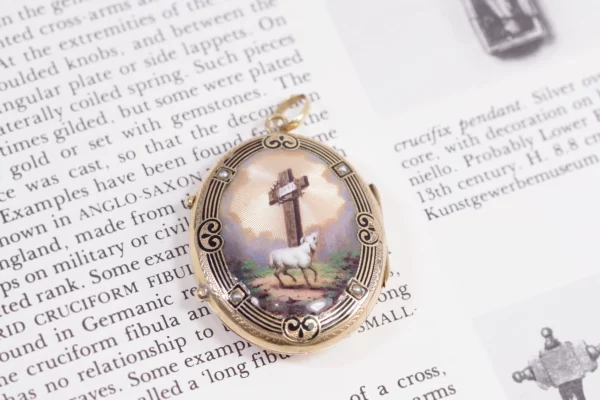
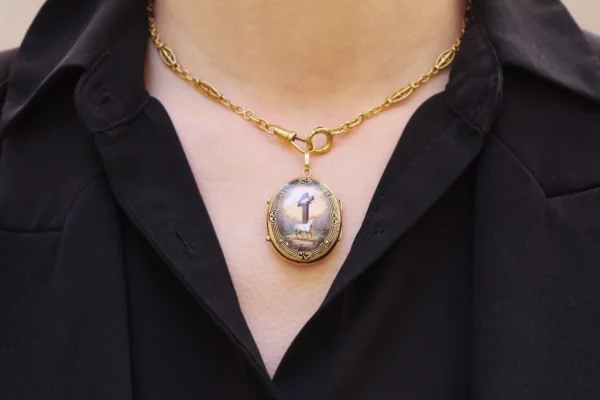 1300,00€
1300,00€Enameled Swiss antique locket in 14 karat gold. Antique opening medallion with enamel decoration on a guilloché background depicting a lamb at the foot of the Cross, bearing the inscription “INRI”, meaning the Latin words Iesus Nazarenus Rex Iudaeorum, i.e. “Jesus the Nazarene King of the Jews”, whom Pilate had placed on the Cross. Jesus, also known as the “Lamb of God who takes away the sins of the world”, is likened to a sacrificial lamb. The contours of the medallion are decorated with fine half-pearls and black enamel. The reverse of the pendant is decorated with chasing and black enamel forming hearts around a rhombus. The locket can be opened to conceal a photograph. It can be worn either way. Antique opening pendant, circa 1880, Switzerland.
Trefoil hallmark for the clasp in 9k, the rest tested 14 karats
Height (including setting): 42 mm
Width: 27 mm
Depth: 9 mmCondition: tiny missing at bottom left, fine scratches
Weight : 6.68 gr
*The antique gold chain is not sold with the jewel*
See our antique chains -

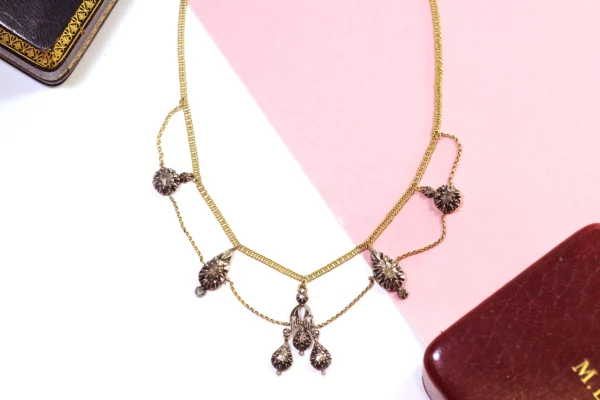 3000,00€
3000,00€French regional diamond drapery necklace in 18 karat (750) yellow gold and silver. Antique regional necklace made up of five silver elements set with rose-cut diamonds. The central pendant holds two dangling diamonds. Round cable mesh chains link each diamond-set element. The main chain is antique yellow gold. Antique Arles drapery necklace, Provence, late 19th century, France.
Boar and eagle head hallmark on the chain, horse head hallmark on the chain (french state hallmarks for 18 karat gold and silver)
Total length: 39 cm
Dimensions of central element: 35 x 25 mmCondition: the clasp is not centred on the chain
Weight : 17.09 gr
*The antique boxes are not sold with the jewel*
-
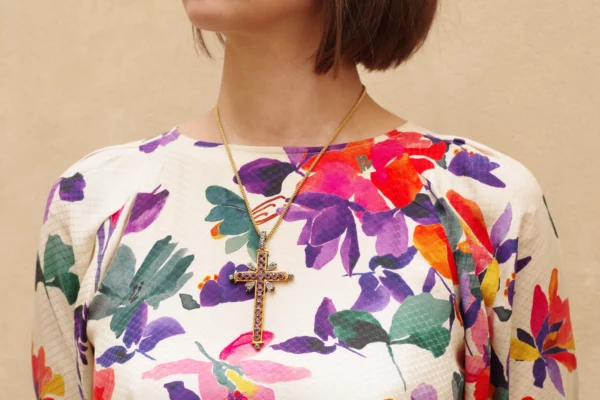
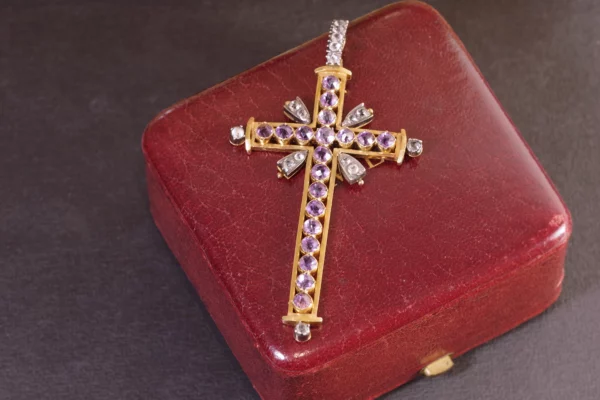 3900,00€
3900,00€Large amethyst cross pendant in 18 karat (750) yellow gold and silver. Large religious cross to be worn as a pendant, set with 19 round facetted amethysts and paste white stones. Religious ceremonial jewellery, late 19th century, southern France or Italy.
Owl and swan hallmarks (French State hallmarks for 18 karat gold and silver).
Dimensions: 90 x 50 mm
Condition: scratches from use, small dents.
Weight: 28.86 gr
*The antique box and the chain are not sold with the jewel*
See our antique chains -
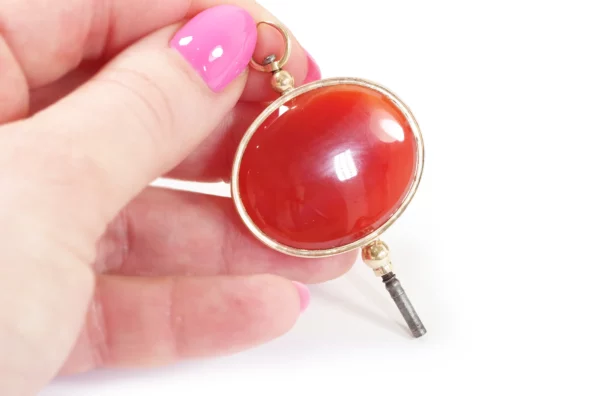
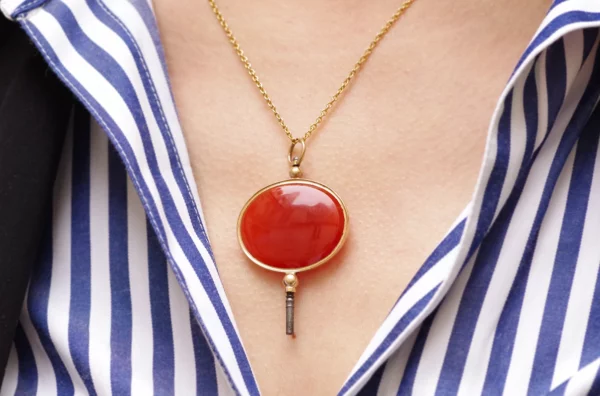 550,00€
550,00€Victorian carnelian watch key pendant in 18 karat (750) rose. An antique watch key pendant, adorned with a large orange cornelian. The structure is rose gold, but the key is metal. Late 19th century jewelry, Victorian period.
Owl hallmark
Dimensions: 57 x 33 mm
Condition: Scratches from use on the metal. The key at the bottom is in metal.
Weight : 11.45 gr
*The antique box and the chain are not sold with the jewel*
See our antique chains -
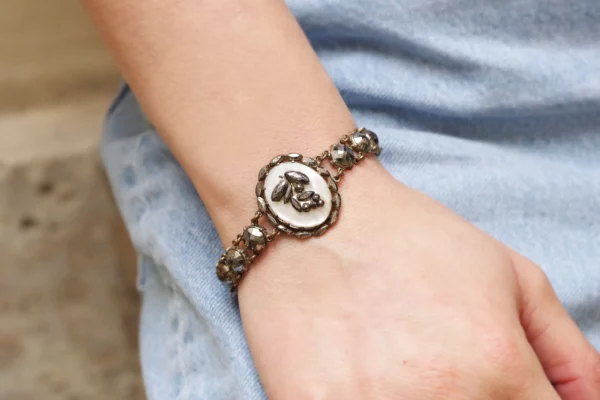
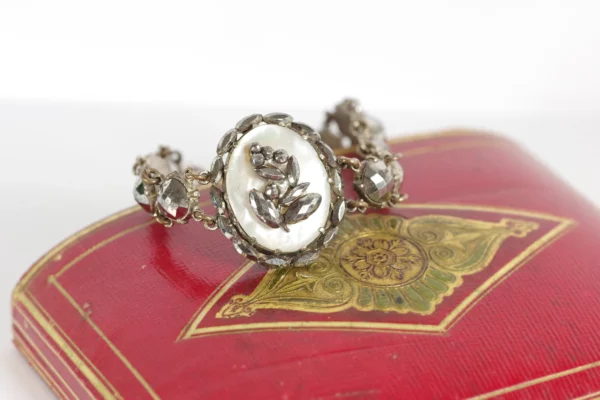 250,00€
250,00€Antique flower cut steel bracelet with circular faceted steel links. In the center, a studded steel flower is set on a mother-of-pearl plate. Faceted steel has a way of shimmering in the light, giving off a beautiful metallic reflection. The latch-box clasp is concealed behind a link. Early 19th century bracelet, circa 1830.
Total length: 16.8 cm
Design size: 28 mm x 25 mmCondition: some oxidation
Weight : 22.34 gr
Steelpoint jewelry: In the 18th century, the most famous workshop was located in Woodstock, England, near Oxford. The fashion for steel jewelry spread to the end of the 19th century in England and to the beginning of the 20th century in France. The advantage of steel is that, when cut into facets, it can sparkle in the same way as pyrite and imitate the brilliance of a diamond.
Originally accessible to a middle-class clientele, steel jewelry became the prerogative of the nobility as soon as it adopted a particular decoration, becoming increasingly sought-after and expensive.
-
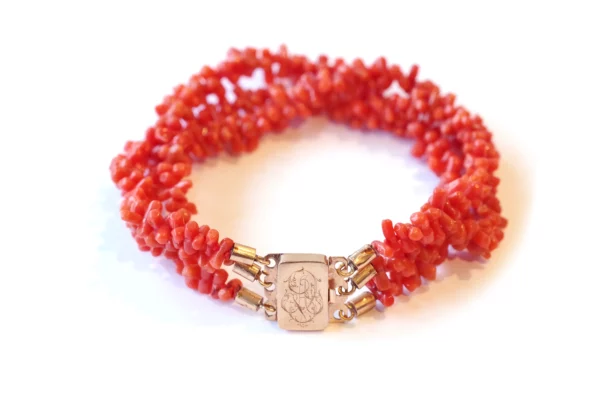
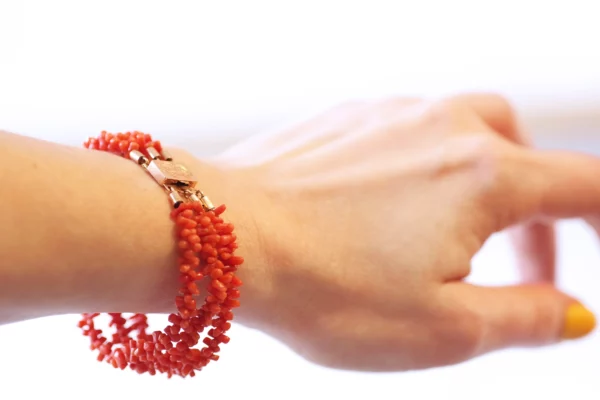 900,00€
900,00€Antique coral bracelet and clasp in 18 karat gold (750). Antique bracelet formed of three rows of coral sticks, joined by a delightful clasp decorated with letters. The clasp is a 14 karat (585) rose gold box, marked with letters “AV”. Antique jewelry, circa 1950. Owl hallmark.
Length : 17 cm
Width: 1.5 cmCondition: light usual wears on the gold
Weight : 14.05 gr
-
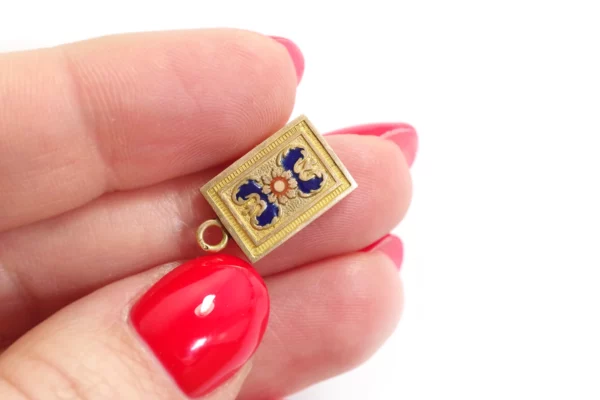
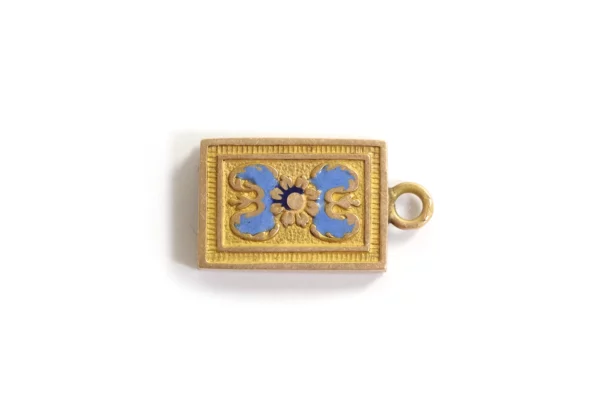 210,00€
210,00€Small enameled clasp pendant in 18 karat (750) gold. This Normandy clasp, in hollow gold. It is decorated with colored enamel: on one side, a red enameled flower framed by midnight-blue leaves, within a cartouche. The cartouche is surrounded by a jagged frieze; on the other side, the same motif […]
-
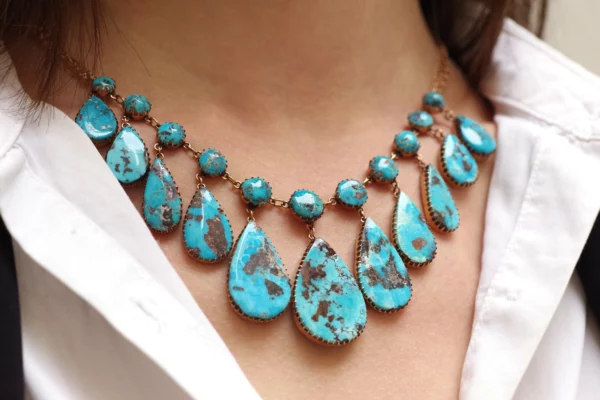
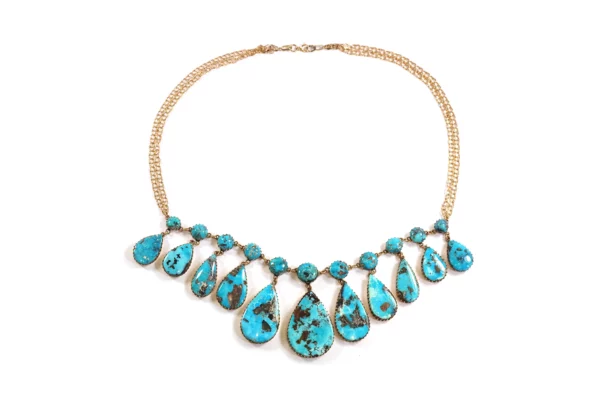 3700,00€
3700,00€Russian turquoise drapery necklace in 14 karat (583) rose gold. Drapery necklace composed of eleven drop-shaped turquoise plaques on matrix (visible on back), topped with round cabochons. The necklace is finished with a double chain of flat links. The turquoise may have come from Kazakhstan, a country under Russian rule since the 17th century, where turquoise mines are still found, but more likely from Persia, which supplied countries and courts with its beautiful, intense-blue stones. Turquoise from Kazakhstan is generally blue with a hint of lavender inside, suggesting Persian turquoise. Necklace circa 1900, chain changed afterwards.
Shell hallmark, on the chain, certainly changed after the necklace was made: Russian “sickle and hammer” hallmark (active after 1958), SAS or GAS hallmark on the clasp.
Total length: 42 cm
Dimensions of largest drop: 21 x 45 mmNote: The slight difference in gold color between the chain and the necklace suggests a modification of the jewel.
Condition : wears of useWeight : 35.20 gr
About turquoise: Read our article by clicking here.
-
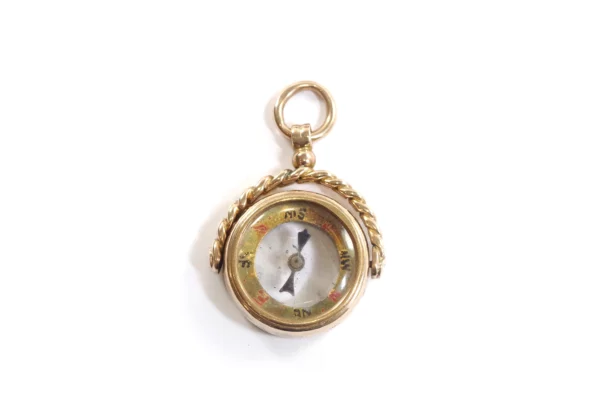
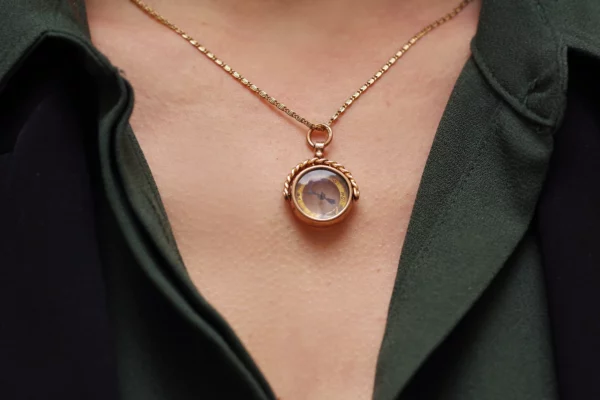 750,00€
750,00€Victorian compass pendant in 9 karat gold (375). A very original compass-shaped pendant that can be rotated on itself, allowing it to be placed on the table to find North. Inside, an arrow rotates on the cardinal points. The compass is two-sided, with both sides protected by glass. It is decorated with a gold cord that holds the hoop. The North indication works. Made in England, Birmingham, 1891.
Clover hallmark, Marks: Marine anchor (Birmingham), R for 1891, MW.
Dimensions: 32 x 20 mm
Diameter: 20 mmCondition: dust inside the compass, slight dents, wear light scratches on gold and glass.
Weight: 5.26 gr
*The antique box is not sold with the jewel*
Learn more: How does a compass work? A moving needle inside the compass reacts to a magnet, the Earth. Indeed, as our planet contains a lot of iron, it is magnetic, and the small moving needle inside the compass uses this to indicate the north-south direction. However, this only works if there are no other magnets near the compass. Note that the needle of a magnetic steel compass always points approximately north.
-
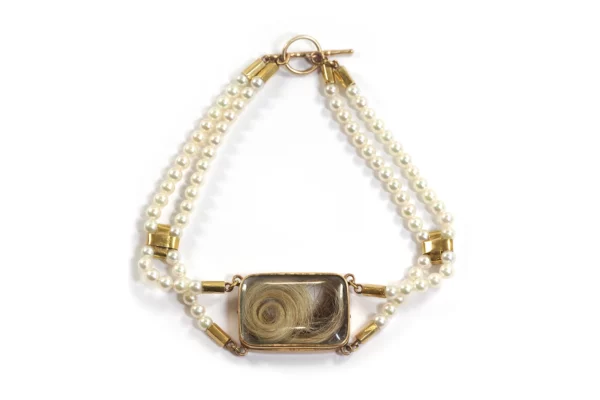
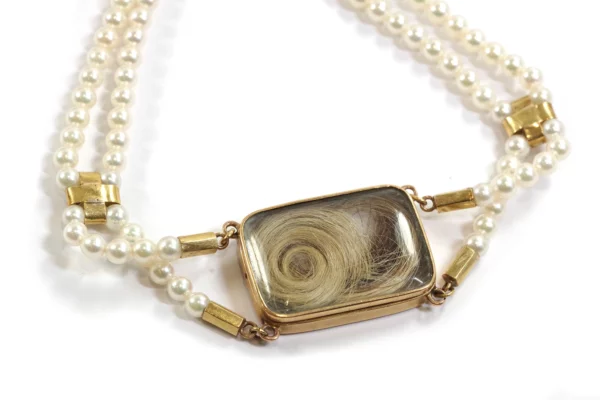 1300,00€
1300,00€Reliquary pearl bracelet in 18 karat (750) rose gold. The bracelet is composed of two rows of cultured pearls linked by a gold cruciform element. In the center of the bracelet, a rectangular gold element holds a lock of hair, protected by a curved glass. The clasp is with a gold stick, which is passed through a ring. Antique reliquary bracelet, late 19th century.
French owl hallmarks on various parts of the bracelet (french state hallmark for 18 karat gold)
Total length: 19.5 cm
Dimensions of central element: 24 x 15 mm
Diameter of beads: 3.4 mmCondition: scratches from use
Weight : 12.53 gr
-
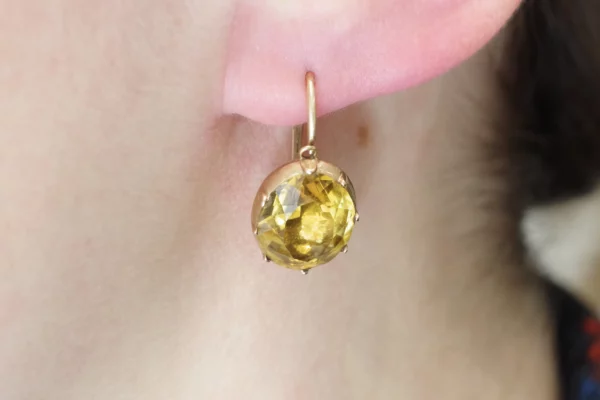
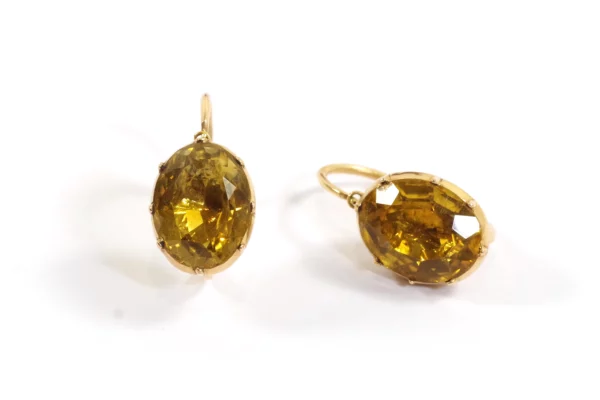 1300,00€
1300,00€Georgian citrine earrings in 18 karat (750) and 14 karat (585 for the clasp) rose gold. Antique earrings set with large oval faceted citrines. They are closed-set and on a foil, creating a warm, luminous effect. Antique earrings in very good condition, Georgian period, circa 1830.
Shell hallmark (punched later on the buckle fastening).
Dimensions: 19 x 10 mm
Condition: fine wear scratches
Weight : 4.69 gr
-
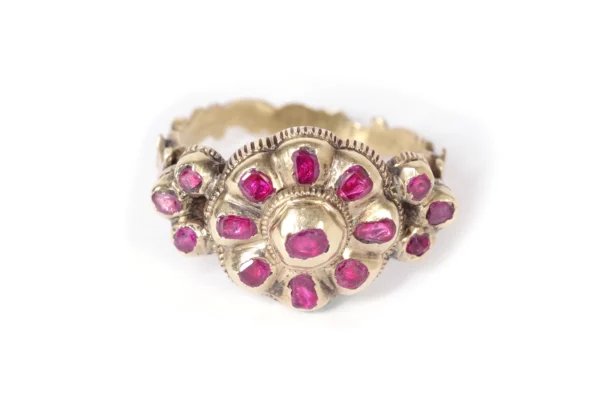
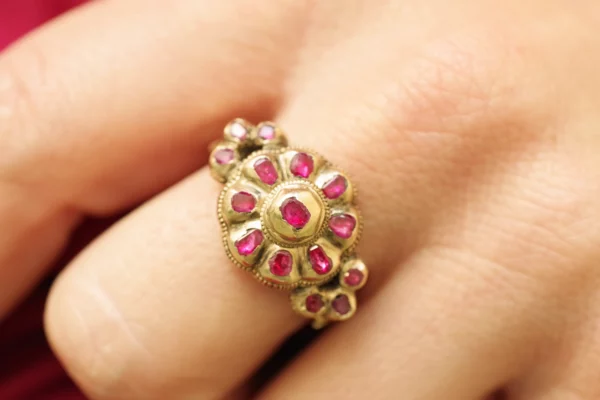 Out of Stock
1,00€
Out of Stock
1,00€Georgian Italian ruby cluster ring in 14 karat gold (585). Late 18th century cluster ring with 9 table-cut rubies. Each shoulder of the ring is also set with 3 rubies. The ring is richly decorated with rinceaux and stylized leaves. Like most rings from this period, the ring head is secured with a rivet. Ring from the Mediterranean basin, probably Italy, circa 1780.
Shell hallmark (French State hallmark for 14-karat gold)
Finger circumference: 56 EU or 7.5 US (possible sizing at the risk of missing ring decoration).
Bezel dimensions: 14.8 mm x 15 mm
Condition: scratches from use
Weight : 5.4 gr
More information : there are several examples of rings identified as Italian in the British Musuem, and although it is known that these designs were also made in Spain, there are no Spanish models referenced in museums. However, this style can be found throughout Southern Europe: Italy, Spain and Portugal, and can be explained by the presence of the Habsburgs during the 16th and 17th centuries in regions such as Sicily, Sardinia, Naples and Milan.
